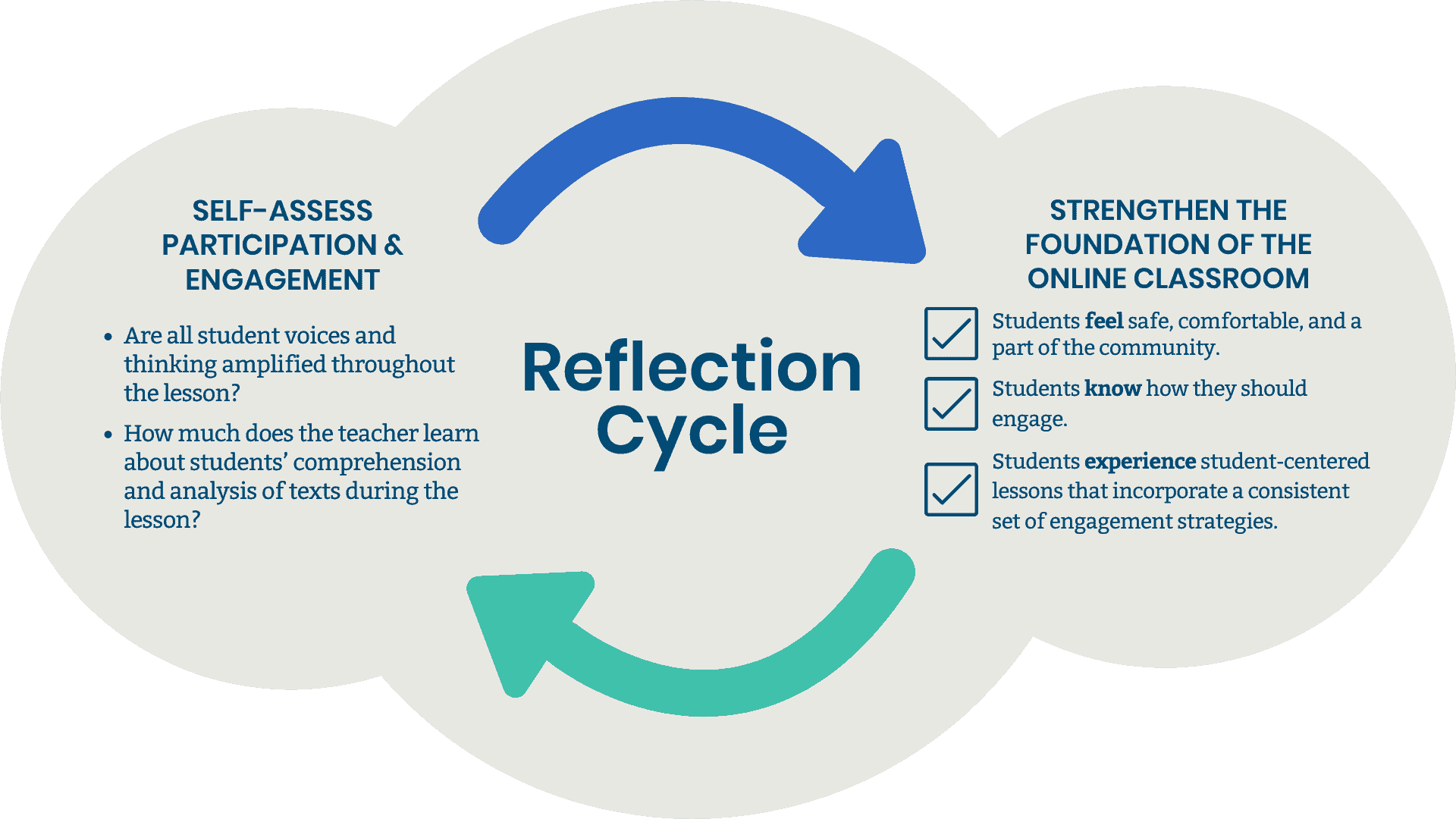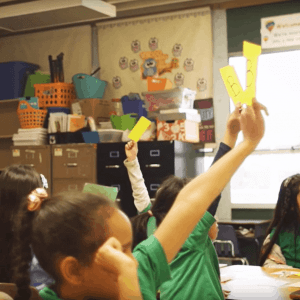
Are My Students Engaged? How to Self-Assess Virtual Participation in ELA
12/11/2020


“I’m teaching, but are my students engaged and participating in a meaningful way?”
This question has always mattered, but remote instruction can make it more challenging to answer now. Some students are not regularly on screen for various reasons. Other students readily chime in on the chat but disappear during small group break out discussions. All of us—students and teachers alike—are still juggling many new experiences that come with us when we enter the virtual classroom. While we cannot rely on the same signs of engagement that we have in a face-to-face classroom, we must still know students are learning, safe, and feeling connected. Therefore, we must expand our toolbox of strategies for the online space.
Our partners at Detroit Public Schools Community District were feeling many of these same challenges in a step-back meeting a few weeks ago. So, our team dug deep into our well of past classroom experiences and scoured resources developed by educators across the country to create a guide for ongoing reflection on engagement and participation in ELA. We’re sharing it here in the hope that it helps you strengthen the foundation for your online instruction, too. Let’s dive in.
The Reflection Cycle
Everyday, your classroom culture is changing and evolving, even online. What you do today impacts what is possible in later learning. Therefore, you may want to think about setting intentions for online ELA instruction in a reflection cycle. On one end, you have overarching questions to hold top of mind as you observe behaviors and experiences. On the other, you have three components for your foundation.

Self-Assessment
Use the rubric below to reflect on the degree and quality of student engagement you have seen in your online classes. You might also consider sharing the rubric with students and inviting them to assess how the class is doing; that gives them the agency to generate ideas for active engagement as well.
Build on Your Strengths
After you self-assess, think about how you’ll structure your lessons to strengthen student participation. Below, I listed a few ideas and linked resources to guide you. Choose the approach that works for you and your students.
-
Make sure students feel safe, comfortable, and a part of the community
Feeling safe and comfortable is necessary for any student to engage. Engagement strategies and lesson plans will fall flat unless students feel safe in class. Work with students to develop (or revise) the classroom contract for online learning (Facing History).
While teaching, share how you personally connect with the content (for example, “This Do Now question makes me think of my daughter . . .” or “I have read this story at least ten times, and every time I find something new!”). That can open the door to making connections to their own life. Low-stakes, informal questioning can be a great tool for building rapport and making connections. Try:
- inviting students to share how they are feeling at the start of class by chatting their roses and thorns or sharing an emoji.
- using Do Now questions to launch the class.
- using an instant poll to gather students’ opinions and invite discussion of the results.
Finally, create regular time and space to engage in mindfulness practices (Edutopia, Tufts University). While your students are dealing with so much that might be new to them, choose language that is motivating and that focuses on their agency. Students who are frequently less engaged might benefit from additional check-in. If many students are unengaged, choose a subset of students to check in with. Ask them:
- When do you like to participate in our class? When do you prefer to hang back?
- Are there any classes where you participate a lot? What can you tell me about them?
- What do you wish I knew about you?
- Is there anything we could do differently in class to help you participate?
-
Help students understand how they should engage
Remember, participation in the virtual classroom comes with different norms, limitations, and opportunities. You set expectations by always specifying how students should respond (for example, “Read the Do Now question and respond in the chat”, or, “The reporter from each group will come off mute and share what you discussed. Let’s start with group 2.”). For group discussions, you might want to teach students hand signals they can use for equity of voice (Edutopia) and encourage students to use accountable talk (LearnZillion).
Regardless of the platform you’re using, you probably have a valuable chat feature that should come with its own guidelines such as these:
- “Don’t worry about proofreading your messages in the chat.”
- “If you have a question, start your chat with ‘Q’”
- “Use words unless I ask you to use an emoji”
Last, let students know when they should be doing something differently by regularly providing feedback about the level of engagement. This might sound like, “During yesterday’s discussion, we heard from about half the students in this class. I know that everyone in here has a perspective that’s worth hearing – let’s make it our goal to hear from everyone every day.” Another approach is to invite students to self-assess their level of engagement and to make suggestions about ways to approach the class.
-
Make sure you’re designing student-centered lessons that incorporate a consistent set of engagement strategies
Choose three or four engagement strategies that will be your go-tos so students know what to expect. I know students (and teachers!) may become bored of using the same strategies, but changing strategies and tech tools too often can cause confusion. Having a handful of strategies ensures a balance of variety and predictability.
When asking students to do something, decide how you will hold them accountable. Use a variety of approaches, including real time, lagging, and implicit accountability. During the class’s independent work time, you can have one-on-one or small group check-ins. Check-ins should help you build connections with students while assessing understanding and providing instruction and feedback. See an example from Achievement First based on Zaretta Hammond’s Culturally Responsive Teaching work.
All of this planning should still build from a foundation of standards-aligned materials that ensure access to priority content for the grade. As my colleague Precious Boyle writes, engagement does not necessarily equal engagement. Student Achievement partners has a wealth of resources about priority instructional content to support your planning.
This has been a challenging year for all teachers, but I know you can do this. You’re not in this alone. Hold the time to step back to self-assess each week, and draw energy from connecting with your students, Master Teacher, and colleagues. Likewise, if you have more ideas to share that have worked for you, let us know via email or tweet @leadingeds.
(Photo credit: Allison Shelley for American Education: Images of Teachers and Students in Action)






